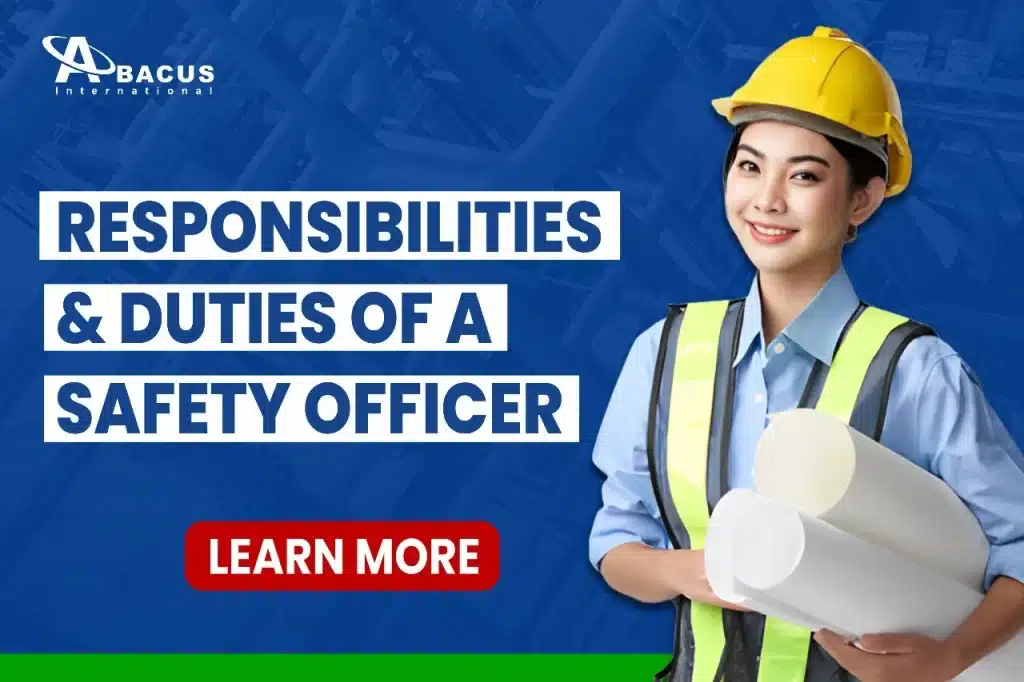Workplace safety is to protect employees, ensure that businesses avoid fines, legal issues, and operational disruptions. Organizations across globe, especially those with higher risk profiles like construction and manufacturing, are highly dependent on safety officers to maintain a safety culture.
A safety officer is a professional responsible for ensuring the health and safety of employees within a workplace. Their duties cover a wide range, from conducting inspections to creating safety programs and responding to emergencies. The ultimate goal of a safety officer is to minimize risks, prevent workplace accidents, and ensure compliance with safety standards.
#1 Ensuring Compliance with Safety Regulations
One of the core responsibilities of a safety officer is ensuring that the organization complies with local, national, and international safety regulations.
Understanding OSHA and Other Standards
The Occupational Safety and Health Administration (OSHA) sets standards that employers must meet to ensure a safe working environment. Safety officers need to be well-versed in these standards and local and industry-specific safety regulations. They must also keep up with changing laws and make necessary adjustments to the company’s policies.
Conducting Regular Inspections
Regular safety inspections are crucial for identifying risks before they become problems. The safety officer must inspect workplaces, tools, equipment, and processes to ensure everything is up to standard. Any deviations from safety norms must be addressed immediately to prevent accidents.
Also Read: Types of Hazards in the Workplace
#2 Developing and Implementing Safety Programs
A safety officer is tasked with creating, implementing, and maintaining effective safety programs tailored to the organization’s specific needs.
Customizing Safety Programs
Every work environment is different, and so are its safety requirements. The safety officer designs programs that suit the organization’s unique setup, whether in construction, manufacturing, or any other field. These programs often cover procedures for safely operating equipment, handling hazardous materials, and responding to emergencies.
Employee Training and Awareness
Safety programs are only effective if employees understand and follow them. Safety officers develop and lead training sessions to ensure that every employee knows the protocols and is prepared to follow them. This can include fire drills, first aid training, or emergency evacuation procedures.
#3 Conducting Risk Assessments
An essential aspect of the safety officer’s job is risk assessment. This involves identifying hazards, evaluating their potential impact, and finding ways to minimize the risk.
Identifying Hazards
Hazard identification involves recognizing any workplace physical, chemical, biological, or ergonomic risks. Whether it’s faulty machinery, slippery floors, or repetitive strain, a safety officer must be adept at spotting potential dangers that could lead to accidents or health issues.
Implementing Control Measures
Once hazards are identified, the safety officer implements control measures to mitigate them. These can include engineering solutions like machine guards, administrative controls like rotating shifts to reduce fatigue, or ensuring the availability and proper use of Personal Protective Equipment (PPE) such as helmets, gloves, or goggles.
Also Read: Fire Risk Assessment (Checklist & Guide)
#4 Investigating Incidents and Accidents
Even in the safest environments, accidents can happen. When they do, the safety officer’s responsible for investigating the cause and preventing it from happening again.
Root Cause Analysis
The safety Officer conducts a thorough investigation to determine the incident’s root cause, whether it was human error, equipment failure, or procedural shortcomings. This often involves interviewing witnesses, reviewing CCTV footage, and examining the scene of the incident.
Reporting and Documentation
After the investigation, the safety officer is responsible for preparing detailed reports that outline the cause of the incident and suggest measures to prevent similar occurrences. These reports are crucial for internal assessments and are often required for legal compliance or insurance purposes.
Also Read: Commonly Overlooked Safety Issues
#5 Promoting Health and Safety Culture
A key responsibility of a safety officer is to foster a culture of safety within the organization. This means making safety a part of everyday work life rather than just a set of rules to follow.
Leadership in Safety Initiatives
The safety officer often leads safety committees or teams within the organization to prioritize safety at every level. They may organize safety campaigns, distribute safety information, and encourage employees to report potential risks or near-misses.
Employee Engagement
Engaging employees in safety matters is crucial for creating a robust safety culture. Safety officers encourage employee participation by organizing regular safety meetings, suggesting improvement opportunities, and rewarding employees who are committed to safety protocols.
#6 Emergency Preparedness and Response
Being prepared for emergencies can save lives and reduce the severity of accidents. The safety Officer’s job is to ensure that the organization is ready for any crisis that might arise.
Developing Emergency Plans
The safety officer develops emergency response plans detailing the steps employees should take in various emergencies, such as fires, chemical spills, or medical emergencies. These plans must be clear, well-communicated, and regularly updated.
Organizing Drills
Regular emergency drills ensure that employees are familiar with the emergency response procedures. Safety officers coordinate fire drills, evacuation simulations, and first-aid drills to test the company’s readiness and improve the response time during actual emergencies.
Also Read: Common Safety Signs & Their Meanings
#7 Maintaining Safety Documentation
Proper documentation is a crucial part of safety management. Safety officers are responsible for maintaining up-to-date records of all safety activities, including training sessions, inspections, incident reports, and safety audits.
Record Keeping
Accurate record-keeping is essential for both compliance and internal evaluations. These records can also be crucial during audits or investigations, providing evidence that the organization is taking appropriate safety measures.
Monitoring Safety Metrics
Safety officers track various safety metrics, such as accident rates, near-miss reports, and training participation, to gauge the effectiveness of their programs. Analyzing these metrics helps identify trends and make data-driven decisions to improve safety performance.
#8 Collaborating with Management and External Authorities
Safety officers don’t work in isolation; they collaborate closely with management teams and, when necessary, with external authorities.
Partnering with Management
The safety officer works with senior management to align safety goals with organizational objectives. They may also propose budget allocations for safety measures, such as purchasing protective gear or upgrading facilities.
Liaising with Regulatory Bodies
Safety officers often represent the company when dealing with regulatory bodies like OSHA or local health and safety authorities. They ensure that the organization complies with all regulations and assists in any required inspections or audits.
#9 Managing Health and Wellness Programs
A proactive safety officer also contributes to the overall well-being of employees by managing health and wellness programs.
Mental Health Initiatives
Workplace safety isn’t just about physical health. Safety officers may implement mental health initiatives, such as stress management programs, to ensure that employees are mentally as well as physically healthy.
Ergonomic Assessments
Ergonomic issues, such as repetitive strain injuries or back problems, are common in many industries. Safety officers assess workstations and recommend adjustments to reduce strain, ensuring that employees work in a comfortable and safe environment.
Also Read: Basic First Aid Skills Everyone Should Learn
#10 Continuous Improvement of Safety Measures
The safety landscape is constantly evolving, and so should the company’s approach to workplace safety.
Monitoring Safety Trends
Safety officers must stay informed about their industry’s latest safety trends and developments. They regularly update their knowledge by attending conferences, reading safety journals, and networking with other professionals.
Reviewing and Updating Policies
As new risks emerge, revisiting and revising existing safety policies is crucial. Safety officers review and update the company’s safety policies to ensure they remain relevant and practical.
Conclusion
The role of a safety officer is vital in any organization that values the well-being of its employees and the integrity of its operations. From ensuring compliance with safety regulations to investigating incidents and promoting a positive safety culture, safety officers wear many hats.
Their work directly reduces accidents, improves health and wellness, and ensures that the organization operates within legal guidelines. Safety Officers play a critical role in creating safer, more productive workplaces by constantly assessing risks, training employees, and improving safety protocols.
Frequently Asked Questions (FAQs)
What qualifications does a safety officer need?
A safety officer typically requires a background in occupational health and safety, often supported by certifications like OSHA 30 Hours, NEBOSH IGC, or other industry-specific safety training.
How often should safety audits be conducted?
Safety audits should ideally be conducted annually. However, in high-risk industries, more frequent audits may be necessary.
What role does a safety officer play in emergency preparedness?
A safety officer develops emergency plans, conducts drills, and ensures that all employees are familiar with evacuation procedures and first-aid measures to handle emergencies effectively.
What industries require a safety officer?
Industries such as construction, manufacturing, oil and gas, healthcare, and logistics often require safety officers due to the high risk of accidents and hazards.
How does a safety officer contribute to employee well-being?
Besides preventing accidents, safety officers contribute to employee well-being by promoting health programs, ergonomic assessments, and mental health initiatives to reduce stress and improve overall workplace safety.


